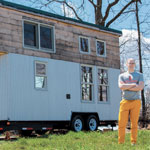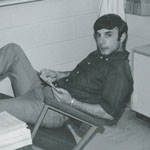
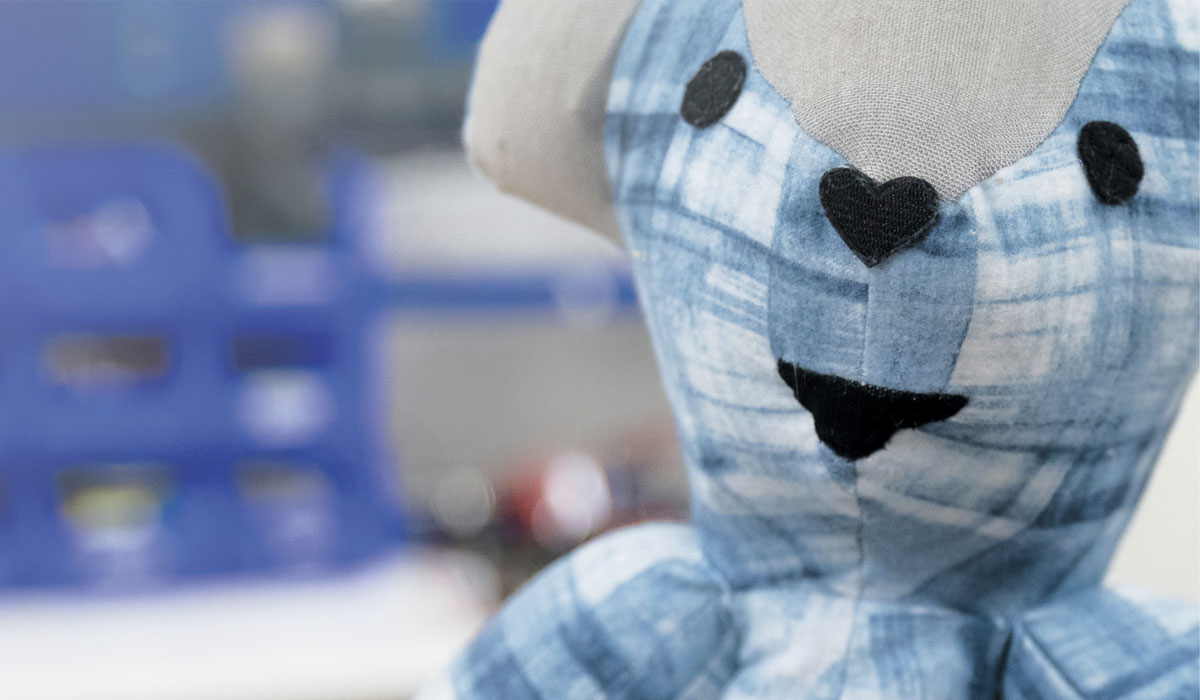
On Nov. 6, 2018, Roger Nelson P ’91, ’93 was scrolling through Facebook when he came across Gettysburg College’s most recent post—an article on then-Digital Technology Summer Fellow Tyler Mitchell ’20, who created an affordable, closed-loop insulin pump in the College’s Innovation and Creativity Lab.
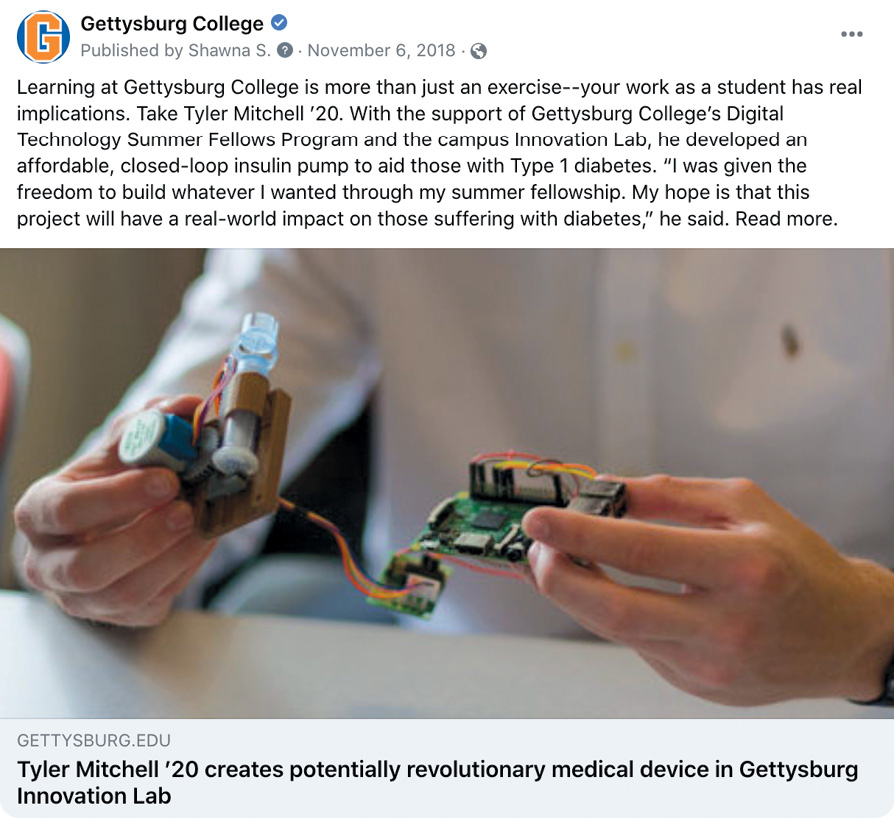
Aha! That’s it! Nelson thought to himself. He quickly sent an email to connect with Vice President of Information Technology and Computer Science Prof. Rod Tosten ’85, who supported Mitchell during his project, alongside Director of Educational Technology Eric Remy.
“It was providence,” Nelson said, remembering this serendipitous moment on social media, as just a few days before he had visited his sister-in-law and her husband in their live-in memory unit in Virginia. It was during that visit that an idea was stirred—one that could help individuals with varying levels of decreased cognitive function due to Alzheimer’s or dementia. It had the potential to improve their long-term memory and increase feelings of comfort and connection.
That idea was CueTeddy.
“I noticed that many of the residents were carrying around stuffed animals, and my sister-in-law had this little white rabbit,” Nelson said. As he watched her carry this rabbit everywhere, he also realized those in the memory unit often preferred spending much of their days passively watching TV, some even with their stuffed animals in tow, rather than engaging with one another. “And I thought, well, why not have the rabbit talk to the individual?”
But it was just an idea at the time, and it was all he could think about.
Serving as a visiting professor at SOMT University of Physiotherapy in Amersfoort, Netherlands, in late 2018, Nelson had ongoing CueTeddy conversations with a colleague who works for the Dutch health system’s innovation department, Waldemar Hogerwaard. Seeing its potential, Hogerwaard helped Nelson think through how he might be able to have the bear talk, and Hogerwaard encouraged him to find a way to implement the concepts they brainstormed.
With a personal tie to the subject, Nelson was unquestionably motivated to heed his colleague’s advice, but he needed hands-on help transforming this idea into something tangible and lovable—and the Innovation and Creativity Lab was his answer. Tosten, gladly offering his expertise, partnered with Nelson, and several months later, the prototype for CueTeddy was born.
“This concept would have stayed a concept if it wasn’t for Rod,” Nelson said. “He really brought it to life.”
Four years and many tinkering hours since that fortuitous day on Facebook, the most recent prototype, owned by Gettysburg College, has caught the attention of local, regional, and even a few national news organizations. This well-earned spotlight has since inspired floods of emails from people who believe in the bear—families with loved ones suffering from memory loss that believe in CueTeddy’s potential to change lives as much as Nelson and Tosten do.
“It has all just reaffirmed that we’re heading in the right direction and that we’re onto something here,” Tosten said.
The ins and outs of CueTeddy
“How do you spell love?” Piglet asked Winnie the Pooh, to which Pooh replied, “You don’t spell it. You feel it.”
There is something endearing about the love and comfort a teddy bear can provide—consoling a woeful infant, befriending a lonesome child, and even possessing the power to transport an adult back to a place, time, feeling, or memory from the attic of their long-ago youth. For Christopher Robin and the young-hearted across the globe, Winnie the Pooh’s adventures in the Hundred Acre Wood were very real—they embarked on them together. As they read the words in the books or indulged in the story on TV, the beloved and nostalgic bear brought them joy and solace.
Similar to Pooh and the friendship, fond memories, and hope he offered and continues to offer grownups and children alike, CueTeddy takes being a cuddly companion steps farther than a typical teddy bear. It takes this role to heart.
Its soft, fabric exterior is custom-made by a Philadelphia-based designer, Liz Bauman, to be both huggable and able to be cleaned with a disinfecting wipe—a critical design element, as each bear can be programmed to be used by more than one individual. Adding dimension and functionality to its head, ears, and hands are metal-woven patches, purposefully positioned to respond to a user’s prompted touch. Beneath its heart-shaped felt nose, CueTeddy’s mesh mouth, upturned in a gentle grin, allows conversation. Then, on the inside, there’s much more than stuffing: it is home to the motherboard.
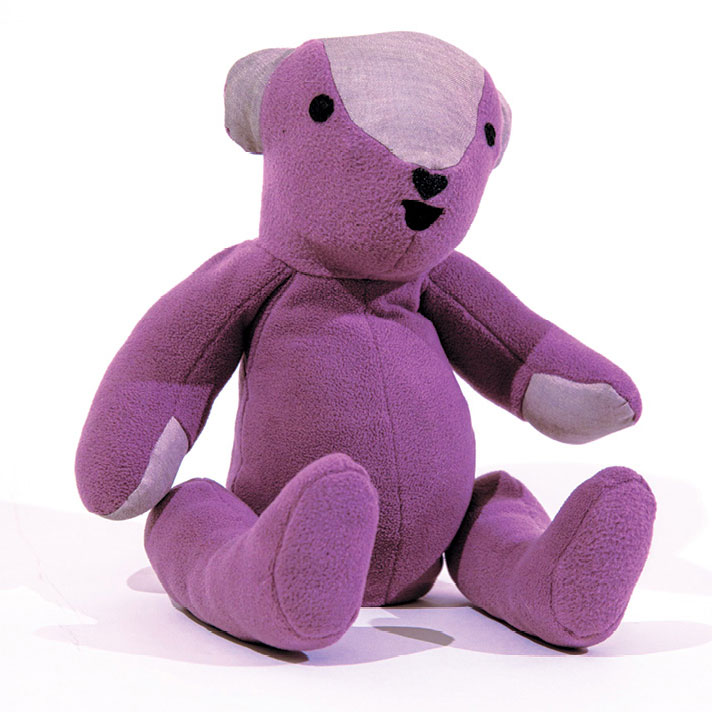
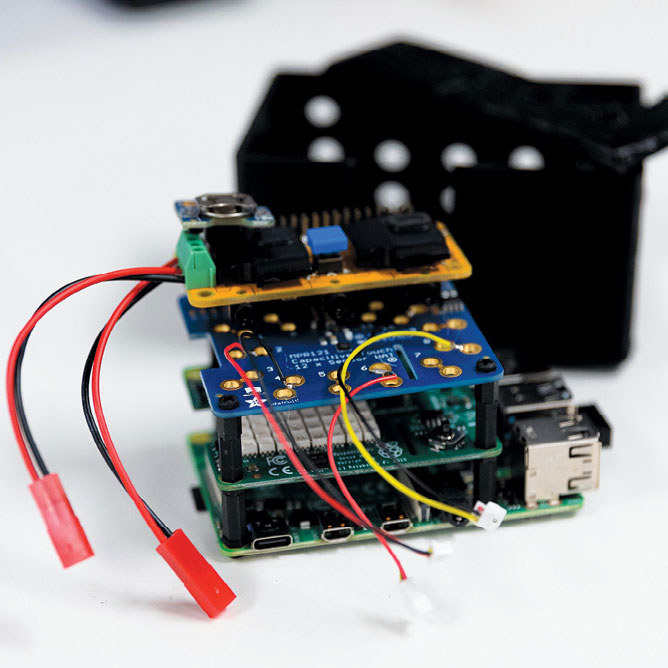
The various technological components that are tucked away beneath CueTeddy’s surface include a lavalier microphone, a soundboard, a connection board, and a tiny computer known in the tech world as “Raspberry Pi”—all of which, and more, are accessible to students in the Creativity and Innovation Lab to build their mind’s innermost ideas, like Mitchell. Together, these pieces make it possible for the bear to connect and engage with the individual, using both cognitive and psychomotor approaches to learning.
What was your pet’s name when you were growing up? What are the seasons of the year? What did your mother cook for Thanksgiving that you really liked?
These are just a few of the countless, customizable questions that CueTeddy can ask—in any voice—to get neurons firing and pleasant memories stirring in minds. “For one resident, we actually recorded her son’s voice,” Tosten said. “She was able to recognize it and was beyond excited to hear her son’s voice come out of the bear.”
“With CueTeddy, you see the cognitive approach at work as the bear asks the person simple questions and the psychomotor approach as they’re prompted to move the bear. Whereas the affective domain, which involves feelings, emotions, and attitudes, is employed as they hug CueTeddy or pat one of its touch-responsive areas,” added Nelson, who has worked in physical therapy for more than 60 years. “We’re able to track these responses too. Rod built in the bear a mechanism that records this information to help us learn how each individual best interacts with CueTeddy.”
Nelson further explained that recent memories are frequently fleeting for individuals with progressive memory disorders like Alzheimer’s or dementia. Many live in an in-between world, somewhere between the present and the past, clinging to the memories that remain. With this in mind, it’s both Nelson’s and Tosten’s hope that CueTeddy combats feelings of isolation among these populations, rather sparking a newfound excitement to engage.
And it’s working. In just a few sessions, those who have used CueTeddy are not only strengthening their cognitive recall, but they’re also smiling more, they’re tapping into feelings of nostalgia and joy, and correspondingly, they’re growing more open to conversing with the bear and with others.
“When I think about the effect it could have at a larger scale, that’s what’s energizing,” Nelson said. That’s what keeps us going.”
Captivating hearts, strengthening minds
During early prototype testing in 2019, the CueTeddy duo vividly remembers the day they returned to a memory unit in Chambersburg, Pennsylvania, to observe five individuals’ interactions with the bear. Due to needed technical work, it had been three long weeks after their last visit. As they always did, they walked in carrying the teddy bears in a yellow sack—much like Santa Claus would carry his bag of toys—and one woman’s face lit up with sheer excitement.
“You’re the guy with the bear,” she said to Nelson.
“She was someone who had a memory of about two minutes, and after three weeks, she remembered working with the bear. That’s truly remarkable,” Nelson said.
These small moments of success brought an abundance of praise, but Nelson and Tosten wanted to perfect their product. They understood that firsthand feedback through their trials would also present areas of growth, which would ultimately bring elements of CueTeddy back to the drawing board.
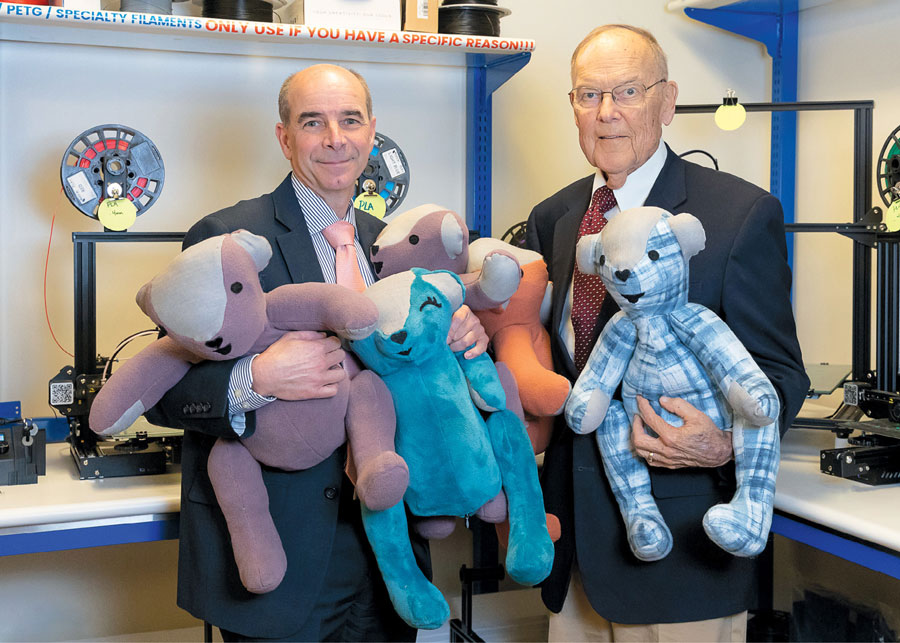
“A lot of times in these entrepreneurial efforts, it’s three steps forward and two steps back,” Nelson added. “We had our celebratory moments and our frustrating moments, but that’s the joy of entrepreneurship. It’s slow, teetering progress.”
One preliminary user with impaired hearing had difficulty with the volume of CueTeddy’s prompts, to which Tosten developed new technology, allowing a customizable audio experience. Now, the bear is equipped with a clip-on Bluetooth speaker.
With each found fault, the improvements have propelled them one step closer to a universally accessible, finished product.
“CueTeddy is not a complex idea, but Roger saw a need and a solution, and we ran with it,” Tosten said. “It’s in pretty good shape for a prototype, but now it just needs to be built a little bit differently. It needs to be commercialized and made turnkey.”
In pursuit of getting CueTeddy on the market, Tosten filed for a patent in July 2020 and a trademark in September 2021. He and Nelson are currently looking to secure additional funding to support their efforts, as well as a strategic partner interested in further developing, marketing, licensing, and manufacturing the bear. As they await patent approval and seek out the perfect partner, they’re sharpening their assets. They’re continuing to iron out kinks in CueTeddy functionality and polishing its website before making it public-facing, with the help of several Gettysburg College students—Daegan Wilcox ’22, Jacobus Hoetmer ’22, and Nikha In-Amkha ’21—as part of their computer science senior capstone projects.
While the long-term goal is to widely distribute the bear in assisted living facilities in collaboration with a global partner, Nelson is committed to ensuring Gettysburg College remains at the bear’s core.
“I’d like to see that we have the Gettysburg College logo somewhere on the bear and get it out across the world into the hands of those who need it most,” Nelson said.
Behind CueTeddy’s heart-shaped nose and in the hearts of those invested in the invention, Nelson sees a care connection. He envisions an ongoing blissful blending between the College and the community, as modeled by his collaboration with Tosten—a culmination of people who not only care deeply about others, but also dare to find creative solutions to problems, together, by tapping into invaluable resources, like the Innovation and Creativity Lab.
In Nelson’s eyes, the bear is just the beginning.
Big change starts small
Tosten’s and Nelson’s ambitions for CueTeddy are rooted in joy, comfort, and hope for those with memory loss and their families. But perhaps it too will serve as someone else’s moment of providence, like Mitchell was for Nelson.
Today, Mitchell is a software engineer at Tandem Diabetes Care—another connection deriving from his work in the College’s Innovation and Creativity Lab.
“After graduating from Gettysburg, I was three weeks away from starting graduate school at Tufts University, and I was on an eight-hour drive from Tufts back home to Maryland when I got a call from Tandem,” Mitchell remembers. Tandem staff had just read the article about his insulin pump work and wanted him to join their team.
Mitchell’s answer was without hesitation: Yes! It was his dream job, and two years later, it still is. Every day, Mitchell is continuing the great work he started at Gettysburg, improving insulin pumps with personal and professional implications—making them more accessible and affordable for those whose lives depend on it, a problem he’s quite familiar with as a diabetic for more than 20 years.
“Without the Innovation and Creativity Lab, I may have never found that passion,” he said.
Witnessing the evolution of the lab and experiencing endless possibilities that have emerged from it, Mitchell is proud to see his alma mater investing in innovation with a continued devotion to problem-solving. Furthermore, he was touched to learn that he’s even played a small role in bringing CueTeddy to life.
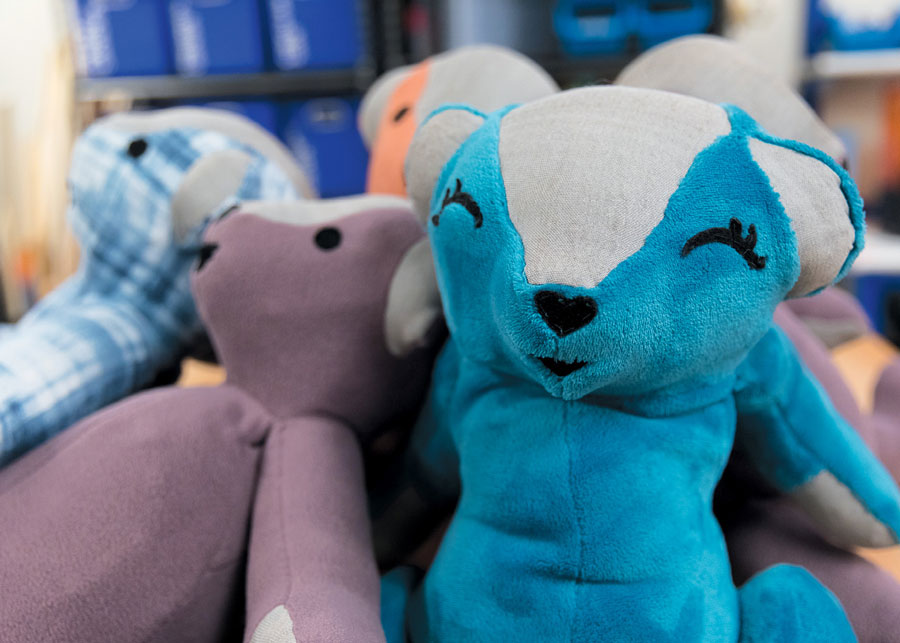
“From the universally-loved form factor they went with to the customizable experience, the whole idea of CueTeddy is so sound,” Mitchell said. “Working in the medical device industry, I often have people running their ideas by me, and it’s been a long time since I’ve found a new, creative idea that excites me like CueTeddy—something that I feel could actually work.”
“And because it’s coming out of my alma matter and the Innovation and Creativity Lab, that excites me even more.”
As confident as Tosten is in CueTeddy, he’s even more optimistic that it won’t be the last head-turning invention to come out of the Innovation and Creativity Lab. He hopes it might inspire Gettysburg College students, alumni, and community members who read this story to follow the trail of something they care about—to take a leap of faith.
“We want students to have A Consequential Education and make a positive impact in the world—to take on the big challenges,” Tosten said. “Here’s two guys and we’re trying to address Alzheimer’s and dementia. It just takes mustering up the courage to do it—to take that first step.”
Are you passionately pursuing innovative work or tinkering with your own solution to a problem? Share your story with alumnimagazine@gettysburg.edu.
If you are interested in partnering with Roger Nelson P’91, ’93 and Rod Tosten ’85 on CueTeddy, please contact them at cueteddy@cueteddy.com.
by Molly Foster
Posted: 11/03/22


